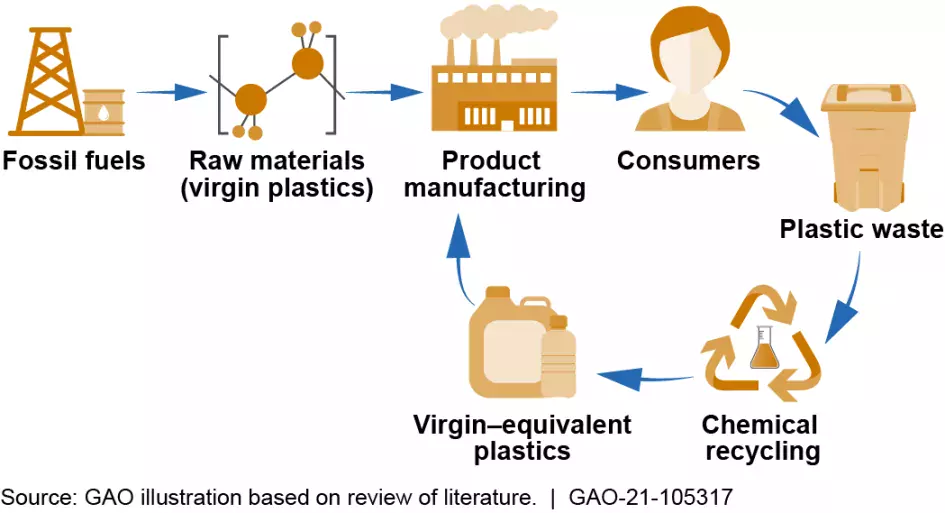Can Chemical Recycling Reduce Plastic Pollution?
Images of plastic bottles washing up on beaches or found in the stomach of ocean life have helped draw attention to the threats plastic waste pose to ecosystems, wildlife, and human health.
From 1970 to 2018 (the most recent data available), plastic waste in the U.S. grew tenfold. While recycling rates remained low, advanced recycling technologies could help increase recycling rates, and in turn reduce waste and pollution, especially if a few key challenges are overcome.
Today’s WatchBlog post looks at our new Spotlight on advanced plastic recycling.
Where does all the plastic go?
The majority of plastic waste in the U.S. ends up in landfills, where it generally does not biodegrade or break down over time. A relatively small portion of plastic waste is incinerated, and an even smaller portion recycled.
Methods of Plastic Waste Disposal in the United States
Image

Plastic waste can also end up in waterways, and eventually make its way into the ocean. In September 2019, we reported about federal efforts to educate about and clean up marine debris, and made recommendations to improve federal coordination and strategies. And while most of these recommendations were implemented, more action is needed to reduce the disposal of plastic waste in the first place. Advances in recycling technology could be one solution.
How is plastic being recycled now?
Currently, the dominant technology for plastic recycling is mechanical recycling, which uses physical processes—such as sorting, grinding, and washing—to recover used plastics. Mechanical recycling technology is expensive, labor intensive, and generally results in lower quality plastics.
For decades, the U.S. recycling industry has relied on selling recyclables in international markets. The Environmental Protection Agency (EPA) is developing a national recycling strategy and set a goal of increasing recycling rates for household and commercial trash from 25% to 50% by 2030. In a December 2020 report, we found that having a domestic market for recyclables would help the U.S. meet this goal.
We also suggested Congress consider clarifying which agency is responsible for stimulating the development of domestic markets, and recommended ways for the EPA to make progress on its strategy.
What is chemical recycling?
Chemical recycling is an advanced form of recycling technology.
Chemical recycling could reduce the amount of plastic that ends up in landfills, thereby potentially reducing the release of harmful chemicals into the environment. Chemical recycling can also produce high-quality raw materials, thereby decreasing demand for fossil fuels and other natural resources. And as this technology develops, chemical recycling could promote domestic businesses and employment, creating create a market for plastic waste and a new way to reuse some plastics.
Further, unlike the recycled plastic products you might be familiar with, chemical recycling has the potential to produce a very high quality recycled plastic, which can be indistinguishable from new plastic.
How does it work?
Chemical recycling technologies use heat, chemical reactions, or both, to break down used plastics into raw materials for new plastic, fuel, or other chemicals.
An Example of a Chemical Recycling Process, From Raw Materials to Recycled Products
Image

While promising, chemical recycling is still fairly new. Some chemical recycling technologies such as those that break down plastic waste into fuel or other chemicals, are in use. However, other processes are still in development, including using chemical solvents to separate additives and other components in plastic waste.
In addition, recent advances in sorting technology (which could be used in both chemical and mechanical recycling) may increase recycling efficiency and lead to increased plastic recycling. One such advancement is the potential use of artificial intelligence technologies to increase automated sorting efficiency.
What challenges need to be overcome with these new technologies?
The hurdles to using chemical recycling include process and technology challenges, high startup and operating costs, and limited incentives for recycling innovation and investment.
Moreover, new plastics produced from fossil fuels are typically cheaper to produce than recycled plastics, in part due to transportation costs and limited recycling infrastructure. This makes recycled plastics less marketable.
In our August 2020 report on the recycling of consumer electronics, we found similar trends with profitability. Like plastic recycling, emerging technologies could help grow a domestic market for recycled consumer electronic materials and reduce the U.S. reliance on imports of these materials.
Key questions for policymakers
With the volume of plastic waste expected to grow over time, some key questions for policymakers include:
- What steps could the federal government, states, and other stakeholders take to further incentivize chemical recycling rather than disposal? What are the potential benefits and challenges of these approaches?
- What steps could policymakers take to support a transition toward a circular economy—one in which products are not disposed of but are recycled for reuse including innovation—and investment in manufacturing and recycling capacity?
- What might policymakers do to promote advanced recycling technologies while also reducing the hazards associated with existing plastic production and recycling methods?
Find out more about chemical recycling technologies by checking out our new Spotlight.
- Comments on GAO’s WatchBlog? Contact blog@gao.gov.
GAO Contacts
Related Products

GAO's mission is to provide Congress with fact-based, nonpartisan information that can help improve federal government performance and ensure accountability for the benefit of the American people. GAO launched its WatchBlog in January, 2014, as part of its continuing effort to reach its audiences—Congress and the American people—where they are currently looking for information.
The blog format allows GAO to provide a little more context about its work than it can offer on its other social media platforms. Posts will tie GAO work to current events and the news; show how GAO’s work is affecting agencies or legislation; highlight reports, testimonies, and issue areas where GAO does work; and provide information about GAO itself, among other things.
Please send any feedback on GAO's WatchBlog to blog@gao.gov.




